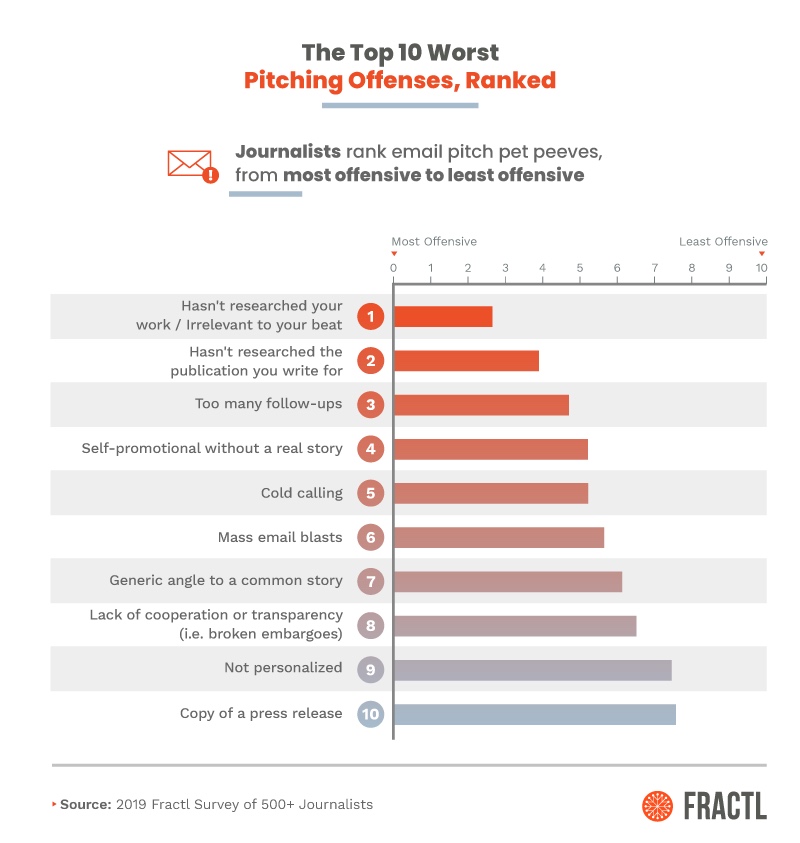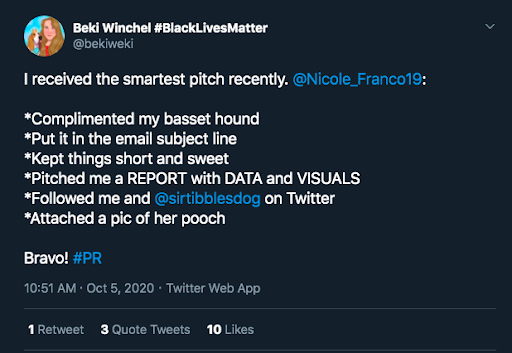Digital PR is an excellent strategy to pair with content marketing, especially if your goals include increasing your brand awareness and improving your backlink portfolio.
When you create excellent content and pitch it to writers, you not only get great media coverage, but you get the link back to your project and the authority that comes with being mentioned in a trusted publication.
This earned media tactic is very effective — but it isn’t easy.
If you get any part of it wrong, your chances of success decrease dramatically. If you’ve run into roadblocks, make sure you’re not making any of these mistakes with your content or your pitching.
1. It’s not newsworthy
Sure, it’s easy to say the news only wants to cover material that is, well, news worthy.
But what does that actually mean?
For content marketers, it usually refers to three criteria: timeliness, relevance and significance.
But there’s a catch: Most content marketing programs don’t have journalists devoted to breaking news like actual media outlets do. So how can you create content that is truly newsworthy without the resources of a newsroom?
By creating and analyzing your own data.
If your brand provides a fresh data set or a new analysis of existing data, then you’re the sole owner of information, and you can offer it exclusively to publications. This makes your pitch much more interesting.
This tactic is a combination of original content marketing and digital PR.
But the content can’t just be timely. It also has to be relevant to the writer you’re pitching and that writer’s audience. I’ll explain more on that in #4.
Finally, significance, which refers to the impact it has on the audience. When you think of local news, this is why they report on things like traffic jams and school closures: It directly affects the daily lives of the people watching and listening.
Alternatively, your data can be significant to writers covering specific beats. For example, for our client Porch.com, we aimed for national coverage but also more relevant coverage on industry sites like Realtor.com.
Knowing we wanted to target niche publications like that one, we asked people about their opinions on HOAs. The project earned coverage on Realtor.com, REALTOR Magazine, Better Homes & Gardens, and more.

Image Credits: Fractl
Significance is tough criteria from a brand perspective, but if you’re able to offer brand-new insights, it’s certainly not impossible.
2. The significance isn’t clear
Imagine a stranger handing you a book with a blank cover and saying, “Here, you’ll find this interesting.” Would you read the whole book?
Probably not. How does this random person know what you’re interested in, and why would you read an entire book to find out if it’s of interest to you?
When you send a pitch email to someone, you’re expecting them to take your word for it that they’ll like your content and that it’s significant for your audience. That’s not good enough.
In the body of the email, you have to explain exactly why the content matters to their readers. Include bullet points with the most intriguing takeaways and callouts that are relevant.
Why? Because odds are they’re not going to want to spend more than a few seconds to discern if this content is worth even looking at. You have to convince them to take that next step and not take for granted that they will.
3. You’re pitching the wrong writers
When you build a pitch list, it’s not just about determining what publications you want to pitch; it’s also about identifying the specific writers who cover relevant beats.
What often happens, though, is people only research as far as the top-level niche, like health or sports, for example. But many writers cover topics more specific than that, like the intersection of health and sports specifically rather than either health or sports generally, for example.
But believe me, this research is an extremely important part of the digital PR process. When we surveyed 500 writers in 2019, their biggest pet peeves were very telling. The two biggest annoyances were that the pitcher didn’t research the writer well enough or that they didn’t research the publication well enough.

Image Credits: Fractl (opens in a new window)
If you identify the right writer, that person has a much higher chance of appreciating what you’re pitching them, because it’s actually relevant, interesting, and something they’d want to share with their readers.
The good news is that if so many people are still making this mistake, this likely means your well-targeted pitch will stand out from the crowd.
4. Your pitch is generic
Even if you target a well-suited writer, your pitch should still be personalized.
I’d argue that a templated pitch can’t be targeted appropriately to multiple writers, anyway, as there will always be nuance about what part of your content will be more interesting to some audiences compared to others.
For example, if you’re pitching the results of a survey you ran asking people their favorite gifts to receive over the holidays, a tech writer that focuses more on SaaS might be interested in highlighting software-related gifts, while a tech writer that focuses more on e-commerce might be interested in the product/marketing side of things.
So, after you’ve done all this research anyway, use it in your pitch. Relate to the person you’re pitching on a human level (either by referencing previous work they’ve written or something you have in common that you discovered via Twitter).

Image Credits: Beki Winchell (opens in a new window)
Then succinctly explain why you think their audience would care about your content and feature key takeaways that speak to that particular audience.
If you take these steps, they’ll know you actually put work into pitching them and will probably be more amenable to considering your pitch.
5. Your pitch is too high-maintenance
This can happen in a few different ways.
First of all, are your pitch emails too long? That same survey of 500 writers found that a majority of respondents preferred pitch emails to be fewer than 200 words.
You risk losing them with anything longer than that, so remember to be straightforward and concise.
Secondly, don’t do the whole, “Reply if you want to see the study!” thing. That’s imposing an extra step on the recipient, and you don’t want to add any friction to the process.
Instead, link directly to the content, so that if they’d like to, they can immediately view it.
Thirdly, is that the only link you’re providing, or are there others? We never include more than three links and stick to one if possible. Don’t make the recipient have to click around too much.
Just like anything else with marketing, you want to make their assessment of their interest in your content as seamless as possible.
6. The content is too on-brand
Content that’s too brand-focused will feel like an ad to writers, and it’ll be an automatic pass.
Assess your content to see if it directly promotes or speaks to your core product or service offering.
If your content involves proving working from home is better for your health, and you’re an at-home office supplier, that information may be a better fit for your blog and not for pitching as news to publishers.
There is an exception, though, which is that if you have the objective data to back up the claim and you make your methodology very clear, it won’t appear as biased, and you can pitch that to writers.
Or, perhaps there’s a conflict of interest at play. If you’re a hotel chain, and you’re releasing a report of the cleanest hotel rooms (and your chain is No. 1), no one is going to trust that as unbiased data because you’re clearly trying to promote your own company rather than provide objective, helpful information.
It may be that your content is too visually branded, as well. Your logo might appear too frequently or prominently or your brand name mentioned too often.
Take another critical look at your content to see if it might fall into any of these traps.
There are a lot of ways to go wrong with content marketing and digital PR, but if you stick with the principles of creating content that provides value to audiences (and you pitch writers who actually speak to these audiences), you have a much better chance of getting media coverage, resulting in more brand awareness, quality backlinks and overall authority.
